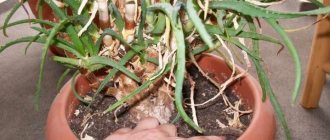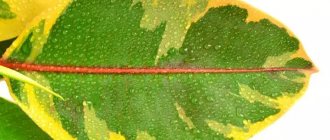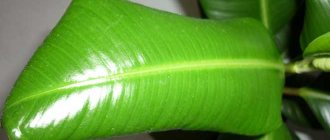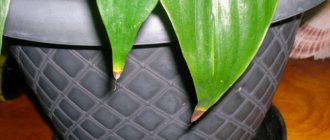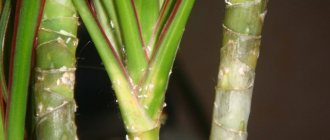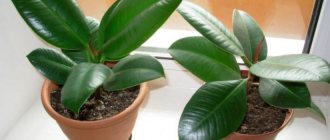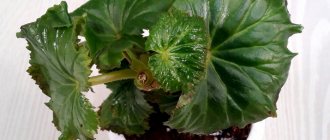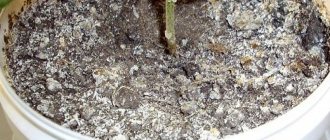Ficus leaves drying out is a problem that anyone who has this indoor tree can face. If you care for it properly, it quickly grows up to three meters, but among flower growers there is a misconception that all representatives of the ficus family are too unpretentious and there is almost no need to care for them.
If you treat the flower this way, it will gradually begin to die: first, the tips of its leaves dry out, then yellow, brown or black spots appear on them. Eventually he will wither away completely. To prevent this disaster, you should follow basic care measures. If the tree begins to hurt, measures must be taken immediately.
Why do the edges of leaves dry out on rubber ficus. Why do ficus leaves dry out?
Why ficus leaves dry out - as already noted, the main reason is improper care in the form of too frivolous an attitude towards it. Both a lack of water and its excess can provoke dangerous diseases, due to which the leaves of the Benjamin ficus begin to either fall off or suddenly change color. In large trees, due to overwatering, they acquire an unsightly black color, and the roots gradually rot. It is worth immediately warning that root rot is a virtually incurable disease, and in severe cases the diseased tree should be disposed of.
If the foliage is not wiped from dust with a soft damp cloth, this may also be an obvious answer to the question of why the ficus dries out. Since it is a tropical plant, lack of moisture sometimes has a detrimental effect on it. Also, lack of light is one of the reasons for this condition, since placing it in the shade is unacceptable. It is a mistake to believe that ficus trees are too tenacious and they do not care how much light they receive: since we are talking about a tropical (albeit domesticated) species, it needs soft, diffused light, the lack of which can be one of the main reasons for wilting.
In addition, you should always monitor the condition of the pot tray: firstly, do not allow the water that flows into it after watering to stagnate, and secondly, when the tree begins to grow rapidly, its roots often grow through the drainage holes of the container. The plant begins to become seriously ill because it is too small and the soil is depleted of nutrients.
When renovations begin in a room, and they forgot to take the tree to another, more suitable place, it often begins to shed its leaves, and they themselves gradually lose moisture and look lethargic and wrinkled. Like any indoor crop, it reacts very sharply to whitewashing or painting. In addition, if the pot is frequently moved from place to place, the same thing happens, but repair work can be more destructive if the flowers are not removed in time.
And finally, parasites, a factor that should be taken into account. For example, an invasion of spider mites, aphids and other harmful insects is always fraught with the fact that they literally suck all the juices out of a home tree.
Causes of yellowing and falling off of Benjamin leaves
- Incorrect plant replanting
Ficus Benjamin needs to be replanted once every two years. This period is considered optimal, since during this time the roots of the flower will have time to completely entwine the soil in the pot. The transplant is performed in the following way:
· First, the plant is pulled out of the container and shaken off excess soil;
· Then placed in another larger flowerpot;
· The bottom of the pot is covered with a drainage layer, and the earth mixture is laid on top of it.
When in a container with a flower there is a small gap between the walls of the flowerpot and the ficus, this distance is covered with soil and fertilizers. After all work is completed, the plant must be watered.
When deciding to buy a ficus, you need to remember that there should be no drafts in the house. All of them are destructive to the flower. When growing a plant at home, it needs to create suitable conditions. By the way, putting the flowerpot in a place where the air conditioner blows is also not worth it.
- Failure to comply with temperature conditions
Correct temperature conditions are the key to good growth and condition of the plant. In winter, the temperature should not be below +18 °C, and in summer - above +25 °C. If the flower is drying, but the room is not hot, then most likely the pot is located next to heating devices.
- Incorrect irrigation regime
If yellow marks appear on the leaf blades, which increase and spread over the entire surface, then the cause may be excessive watering. Constant stagnation of moisture causes gradual rotting and death of the roots. An unpleasant odor spreads from the flower pot.
On sections of rubber-bearing ficus, it is not milky viscous juice that is released, but a brownish liquid. Having noticed the first signs, you can try to save the plant by organizing the correct watering regime. It needs water when the earthen ball becomes dry. An hour after watering, the pan is checked. If excess liquid has leaked into it, it is removed.
If there is a massive dumping of foliage, you will have to check the root system. Moisten the soil in the pot, carefully remove the flower, shake off and wash the roots. Using a sharp knife treated in alcohol, cut off the rotten shoots, pouring powdered activated carbon onto the cuts.
The pot is cleaned using a solution of potassium permanganate (“potassium permanganate”), a drainage layer and fresh soil mixture are laid. Plant the ficus, carefully compacting the soil around the roots. Moisten the soil and place the plant immediately in the selected permanent place, which is not reached by direct sunlight.
- Lack of fertilizers
Feeding a houseplant is an important element in caring for it, because the amount of soil and, accordingly, the nutrients in it available for the root system is very limited. Without receiving the necessary components for normal development, the ficus begins to get sick and shed its leaves. It will be useful for you to know how to feed indoor flowers. Fertilizers should be applied during the period of intensive growth (spring and summer), using universal organic and mineral mixtures. It is best to purchase special fertilizers for ficus plants or, if none are found, combined additives for non-flowering indoor plants.
Why do ficus leaves dry out at the edges? Why ficus leaves turn yellow and dry, the main reasons
There may be several reasons that can cause yellowing and drying of leaves. Before you rush into panic and start pouring and filling the plant with chemical compounds, you should carefully study all the facts.
- Natural leaf fall occurs for each flower. This reason can be easily identified by observing: the falling of the lower part of the foliage; if this fact was discovered in the autumn or winter; It is worth considering that living foliage of ficus plants remains on the branches for an average of 3 years.
- Change in environment. Although the flower is not very whimsical, a sharp increase or decrease in air temperature in the room leads to the fall of the ficus leaves.
- Changes in room temperature also have a negative effect and not only on the branched part of the flower. Sudden hypothermia of the root system leads to leaf fall and root death.
- The influence of external factors from excessive lighting will cause the leaves to wrinkle and dry out, and dried edges or yellow spots indicate excess moisture in the soil.
- A lack or excess of nutrients is reflected in adult foliage and young leaves. Old soil or a cramped pot will lead to slower growth of the plant, the fall of adult leaves of the ficus, and new foliage will not reach the desired size.
Ficus does not bloom - this is not a problem, but a feature
One of the main difficulties that plant growers face when growing ficus is the lack of flowering, despite the normal growth and general condition of the flower.
You will rarely see a flowering ficus, if such an opportunity arises at all. The fact is that the flowers of this plant are not considered beautiful.
In the wild, these plants bloom actively, and this is due to pollination, without which the process of flower formation is impossible.
There are ficus plants that have been recorded blooming at home, but this process is rather an exception. If the desire to get flowers from your plant is still strong, then you can try to create all the conditions for this.
First of all, it is necessary that the air temperature in the room is stable, without changes. The optimal temperature for flowers of this type is 25-30 degrees.
The plant rarely blooms
Any changes can negatively affect the condition of the flower, and even destroy it.
Another important point is air humidity. Ficus plants like to grow in rooms with high humidity. Such indicators are difficult to stabilize and maintain on a regular basis, especially in winter.
In winter, the air is very dry and you need to moisten it using special humidifiers or hang a wet cloth on the radiators and near the plant.
In addition, these beauties love to be bathed regularly. Spraying this plant will speed up its growth and development. Watering also needs to be given special attention. It is necessary to water this plant only when the soil is dry, that is, as it dries out.
In order to check the soil moisture, you can lower your finger into it 3-4 cm; if the soil does not stick to your finger, it means watering is required. The water used for these purposes should not be cold.
Fertilizing soil for ficus
An important step in growing ficus plants is timely fertilization of the soil.
The choice of fertilizers for decorative flowers is huge; it is important to purchase the right mixture, with a maximum of useful substances. It is necessary to fertilize the plant with industrial fertilizers no more than 2-3 times a year.
There are various recipes for making nutrient mixtures and solutions for indoor plants that can be prepared at home.
The lighting in the room where the ficus grows should not be too bright, these flowers love diffused light, in addition, it is not advisable to move the flower pot from place to place; a change of place of residence is difficult for these plants to tolerate.
It should be noted that when trying to achieve flowering of a ficus, you may not get the expected emotions when you achieve success. The flowers of these plants are similar to peas, the same size and color.
There is a small hole in the middle of the flower, which in the wild is used to pollinate the plant.
Why do ficus leaves dry out and fall off? Why do leaves fall and dry out?
Ficus sheds its leaves quite often. As experts say, there is no need to worry about the leaves falling. On average, this occurs more often in the winter and autumn periods of the year.
If a plant has lost about ten leaves, then, as a rule, new, stronger ones will appear in the places where they were, which will also eventually change to young ones. But if the leaf first turns yellow and then crumbles, this indicates that it is important to reconsider the watering schedule. Ficus is picky about this. To eliminate the “baldness” of a flower, you need to clearly find out what amount of water will be normal.
If you water the plant too often, you may encounter another problem - root rot may occur, this will lead to weakening of the shoots and the leaves will fall off. Moreover, if you go too far with reducing the amount of watering, then this will not lead to anything good. In this case, the danger is much greater. The plant will try to maintain soil moisture and the leaves will become more and more weak. The plant will simply decide to get rid of them in order to save more energy for existence.
This does not mean the “end of the world”, since the flower will be able to recover after just a few waterings, but fouling of the leaves may take a long period.
Why do ficus leaves dry out, what to do.
Ficus has been living next to people for hundreds and hundreds of years. Some of its species give us tasty fruits, others provide useful rubber, and still others delight us with their foliage as ornamental plants. Truly, ficus can be confidently called the most popular house plant. Often, beginning “ficus growers” encounter difficulties; the ficus sheds its leaves. dries. How to grow a ficus correctly, how to care for the plant in order to preserve its elegant foliage, we will consider in this article.
Let's start with the fact that there are a lot of types of ficuses and there are also many nuances of caring for different types of plants. Despite their prevalence, ficuses cannot be classified as absolutely unpretentious indoor plants. They require careful care and there is nothing unimportant or small about it. What matters is the place where the ficus is located, the pot and soil in which you placed it, the air temperature, the temperature of the water for watering and spraying, drafts, and direct rays of the sun. Therefore, it is never possible to answer unequivocally the question why ficus leaves turn yellow. a number of observations need to be made.
First you need to understand why ficus sheds leaves. In fact, you should only worry when this shedding becomes widespread, since it is normal for a plant to lose a leaf or two from time to time, because its leaves “live” on average for two to three years. But if several leaves fall out at once and not at the base, but from above, you need to take a closer look.
Analyze whether the conditions for keeping the ficus have changed. Maybe you moved the pot with it to another place, maybe you turned on the central heating in the room or started opening the windows regularly. It was the change in conditions that could provoke plant stress and cause yellowing of the leaves. Most ficus plants are not shade-loving houseplants. they love bright light, but not direct rays. In winter, ficus should also be artificially illuminated. Ficus does not tolerate drafts and may get sick because of this. If, after hypothermia, the leaves of a ficus turn yellow, then you should water it with lukewarm water, place it in a warm, bright place, and also treat it with special preparations - microfertilizers that will help the flower cope with hypothermia.
It has long been proven that most ficus plants perfectly purify the air with their large leaves. Therefore, ficus trees are often placed as indoor plants in the nursery. Explain to your child how to properly care for a ficus, that you cannot cause mechanical damage to its leaves, you need to carefully wipe it from dust and inspect it for possible diseases and pests. The rubber-bearing ficus, whose leaves are large, fleshy, and durable, will cope best with this task. This is one of the most unpretentious types of ficus.
So, everything is fine with the temperature and drafts, but your ficus leaves are turning yellow and falling off. One of the most common reasons for this phenomenon is the presence of improperly organized watering. Overmoistening of the soil leads to rotting of the roots and death of a healthy plant. Therefore, if you see that your ficus is flooded, give it time to dry. This will take several weeks. If after this the plant does not get better, then it will be necessary to replant and cut off the rotten roots. Do not forget that the ficus should be watered and sprayed with settled water at room temperature. It should not be cold so as not to stagnate in the soil.
Another common reason why ficus leaves fall off is all kinds of pests. This could be spider mites, thrips, mealybugs, aphids, scale insects. Each of them must be combated with the help of special drugs and care measures. Pests can be identified in a timely manner by characteristic spots on leaves, the presence of cobwebs, and the like. Therefore, examine your pet more often.
It’s always a pity when a strong, healthy plant just yesterday suddenly begins to get sick, especially when it comes to the fact that a large and old ficus tree is losing its leaves. What to do . After all, having lost all its leaves, the ficus will simply die. Try to fight with the most obvious methods, for example, move the ficus closer to the window so that more light falls on it, in the evening point a fluorescent lamp at the ficus. Move the plant away from the battery. Make sure that the pot does not cool, as the soil will also become supercooled. To avoid this, you can place the ficus pot on a piece of polystyrene foam or a wooden board. Make sure that the ficus leaves do not touch the cold glass, as hypothermia can occur this way. But if the ficus gets too hot, for example under a radiator, you can wrap the pot with a wet towel, place it on a tray with wet pebbles, and cover the ground with damp moss.
We often see that ficus plants are planted with several plants in one pot, intertwining their stems. Of course, it looks very beautiful, such a plant will become a real decoration in the interior, but this can also be the cause of problems with the leaves of the ficus. Leaves fall when different plants begin to fight among themselves for territory, that is, water, nutrients, space. After transplanting the ficus into a larger pot or planting them in different pots, the falling of leaves may not stop, but only as a reaction to the inevitable injury to the roots during transplantation. After acclimatization, the plant’s unpleasant symptoms should disappear.
The most common type of ficus in our country is Ficus Benjamin. The subtleties of caring for it can be considered separately from other types of ficus. He does not like direct sunlight, unlike his dark green relatives, he is more delicate. It does not tolerate dry air, because it comes from tropical rainforests. It is precisely with the frequent use of air-drying central heating that the Benjamin ficus sheds its leaves. Try not to let the air around the plant humidify, from time to time give it a warm tropical shower, covering the soil with polyethylene.
Overmoistening of the soil is also a formidable enemy of the Benjamin ficus, because it is quite susceptible to root rot. Always thoroughly dry the earthen ball, literally to the bottom, and also loosen the soil for better drainage and removal of excess moisture. For the same purposes, a special baking powder additive can be added to the soil during replanting, which is used to improve air exchange in the soil. If the leaves of the ficus benjamina fall off. this could just be a signal that it is over-watered. Water the ficus in combination - both in the pot and in the tray, and after fifteen minutes, remove all the water from the tray.
Do not forget about fertilizing and fertilizers if you are faced with the fact that ficus leaves are turning yellow. Maybe your plant doesn't care
enough nutrients. But if you overdo it with the concentration of fertilizers, you can simply burn the ficus root system. If this happens, you need to put a plastic bag on the barrel, which you will remove in the morning and evening for ventilation. Add some microfertilizers to the irrigation water, and also spray the trunk with irrigation water.
Let's dwell a little on preparing water for irrigation. If the water in your area is hard, it needs to be softened. Boiling helps us with this, and it is better to boil water from a hot tap, it contains less lime. Another method used is freezing. It is necessary to freeze in a plastic bottle, as it is easy to cut off the bottom and remove unfrozen water and salts. Melt the ice and when the water warms up to room temperature, use it for irrigation.
Optimal conditions for ficus resuscitation
The tree can also be removed in more severe cases. It also happens that, due to total leaf fall, only the trunk remains. It is necessary to check how much vitality is still left in it: if it remains flexible and has not had time to dry out, there is a chance to save the rubber plant. If rot and plaque appears on the soil in the root zone of the trunk, you should also not despair: this will require immediate replanting with a scrupulous examination of the root system for damage by nematode pests.
If there are small light lumps on the roots, this is the result of parasite activity. Treating the roots with insecticides and disinfectants will help. An ordinary weak solution of potassium permanganate helps a lot.
The wilting of a tree can be caused by the intensive growth of its root system, which simply no longer fits into the previous container. A transplant will also help here, and the new container should be two to three centimeters larger than the previous one. There is no need to use a pot that is too large.
After transplanting, regular watering will be required, but not earlier than after two days. Fertilizing is carried out only after reliable rooting, after a month. As for the intensity of leaf fall, in autumn, a loss of about twenty percent is the norm, and it is not associated with any diseases or errors in care.
A typical mistake of a gardener who wants to revive a ficus is the desire to feed it as much as possible. This cannot be done, since a weakened plant is simply not able to absorb the complex substances contained in mineral fertilizers, and they will only harm it.
Experienced plant growers on numerous forums are happy to share their experience of caring for the most “difficult” patients among the ficus plants they received. In their practice, there are cases when they had to deal with an almost flown-off flower, on which no more than five leaves remained. For the dried out plant, the soil was completely changed to a suitable nutrient composition and the roots were washed in a manganese solution.
If there were signs of rotting, the diseased roots were removed with sharp pruning shears and sprinkled with wood ash. After transplantation, they added a little fertilizer, placed the flower in a suitable place and shaded it so that the bright sun did not shine on it. Of course, the watering and spraying scheme was adjusted. In most cases, “neglected” rubber plants came to life after a few weeks and began to produce new healthy leaves.
As practice shows, it is quite possible to revive a ficus - even in a very “neglected” state, but in order not to resort to such measures, it is best to properly care for it and take care of it. Then he will not get sick and will always delight the owner with his healthy appearance.
Why do ficus leaves turn yellow and dry? Why do ficus leaves turn yellow?
Ficus, as a houseplant, is valued for its high decorative value. But, unfortunately, there are times when the leaves of a green plant gradually begin to turn yellow and fall off. You should not ignore this process, as without proper attention your plant may die.
In this article we will try to understand the reasons that can cause yellowing of leaves, and will also pay attention to measures to protect the plant from negative environmental factors.
The natural process of yellowing of ficus leaves
The most common cause of yellowing leaves is a natural factor. Adult specimens regularly change their green cover, so if you are confident in the correct care of the crop, it makes sense to determine its age. Perhaps this is what causes the change in color of the leaf plates.
Plant age
In most varieties of ficus, the lifespan of the above-ground parts is no more than three years. After this, they gradually change color, begin to die and fall off.
Figure 1. Natural process of yellowing leaves
As a rule, this process begins from the lower tiers. Moreover, this is an absolutely natural phenomenon that repeats with a certain frequency (Figure 1). A similar process can begin in a young specimen: as it develops, the lower tiers begin to turn yellow and fall off, and the trunk gradually becomes woody. But, if the foliage begins to fall en masse, and affects not only the lower, but also the upper part, it makes sense to pay more attention to the culture. Perhaps you are not caring for the flower correctly, or it has become a victim of diseases and pests.
Ficus leaves turn yellow - reasons
If your ficus is still quite young, or the foliage has begun to fall not only from the lower branches, but also from the top, perhaps this process is pathological and is associated with certain environmental factors.
It is difficult to immediately determine the exact cause of yellowing, so you will have to eliminate each option step by step. Our tips below will help you with this.
Transfer
Ficus trees are very sensitive to changes in their growing location. Therefore, both moving to another place and replanting can cause stress in the plant and it will begin to turn yellow.
In order for the culture to quickly get used to the new place after transplantation, you need to approach this process very carefully. Firstly, it is necessary to use only high-quality soil saturated with sufficient nutrients. secondly, it is not recommended to water the flower immediately after transplantation or treat it with chemicals (even for prevention). It is better to wait until the culture acclimatizes in a new place.
Note: If you simply moved a flower, and it began to turn yellow in response to this stress, you cannot immediately move it to its original place. To prevent the plant from experiencing even more stress, leave it in a new place for 10-15 days, and then move it back.
In addition, yellowing can also be caused by an incorrectly selected pot size. It is not recommended to plant crops not only in too small, but also in too large pots, since excess free space can also cause stress.
Cold
In nature, ficus trees are found in the tropics, so at home they need to be provided with a warm habitat. Drafts are detrimental to these crops. At the same time, it is also important to provide a sufficient amount of light, but exposure to direct sunlight should not be allowed. This can cause sunburn and discoloration of the leaf blade.
To protect your pet from these negative factors, try not to place it in a draft. Choose a warm room with enough diffused sunlight.
Lack of microelements
A lack of nutrients is a common cause of yellowing. The fact is that in a closed pot, the soil is quickly deprived of nutrients, and if the plant does not receive them from the outside, it will quickly weaken. As a rule, this process is accompanied by yellowing.
It is advisable not to combine fertilizing with replanting. If your pet has enough space in the pot, it is enough to add special fertilizer to the soil. If you plan to replant the flower, fertilization can be done no earlier than a month after moving the crop to a new pot.
Improper watering
Another common reason for leaf discoloration is improper watering (Figure 2). Despite the fact that this plant loves abundant and frequent watering, it should not be filled with water.
In order for the ficus to receive a sufficient amount of moisture, you need to wait until the top layer of soil dries completely. Check the moisture level of the substrate by immersing a thin wooden stick into the soil.
Ficus Benjamin description
Ficus benjamina is one of the most popular decorative foliage indoor plants. Its homeland is South Asia, the Philippines, and Australia. In nature, it is a large bush or tree, reaching a height of 8 - 10 m; in indoor conditions it grows up to 1.5-2 meters. The trunk is gray with small streaks. Branches inclined downwards. The leaves are on small petioles 2-2.5 cm, the leaf blade is oval with an elongated tip 4-8 cm long and 1.5-4 cm wide. The central vein is not clearly expressed. The sheet is dense and glossy. Leaf color varies from light green to very dark, and there are many variegated forms.
The ficus leaves turn yellow and dry why. Why do ficus leaves fall off?
Ficus leaves falling off photo
An equally common reason why ficus leaves turn yellow and fall off is a sharp change in microclimate, temperature and drafts. As soon as you touch a leaf to the glass in winter, it immediately turns yellow and falls off. To avoid this, it is necessary to prevent drafts, and in winter - to insulate the pot. When ventilating the room, you need to carefully ensure that the cold air does not harm the plant. Watering should also be done with warm, settled water, because... overcooling of the roots will lead to massive leaf fall.
Ficus trees are true touch-me-nots that don't like to be disturbed. Even a slight shift to a new location can lead to heavy shedding. Taking this into account, it is recommended that after planting, place the pot in a permanent place where it is intended to be grown. As for replanting, this should be done extremely rarely and only if the roots have begun to rise above the surface. It is advisable not to touch the earthen lump, just transfer it to a larger pot. The first watering after this is allowed only after a week.
How to save a ficus if almost all the leaves have fallen off. Is it possible to save a ficus if it is completely naked?
Photo source: flowers.cveti-sadi.ru
How to save a ficus if its last leaves fall off and it remains completely bare?
Even when the last leaves of the ficus benjamina fall off, you shouldn’t get upset, become sad or depressed and hang up! Even a tree that does not have a single leaf has every chance to successfully grow new shoots, thanks to the restorative function of the living microorganism, the necessary effective preventive and therapeutic measures taken in a timely manner, and the ongoing, never stopping efforts to save it.
In order to determine the state of “health” of ficus flowers, you don’t need to use any special effort, everything is quite simple and banal: if milky sap is visible on the stem cut and you can determine by touch that the branches are flexible, barely touching them, then the plant is alive and the state of his “health” is in perfect order, which means that the owners do not have the slightest reason for concern.
And the ficus is actually a magical, homely flower, it can fulfill any home improvement desires. It helps in establishing family relationships and supports the health of the owners of the house. If you want to have a child, bring a ficus into the house, maybe a solid one, or maybe just a twig.

